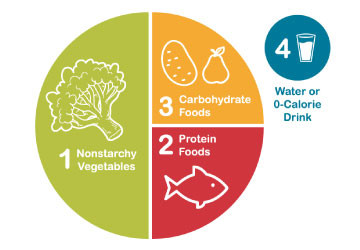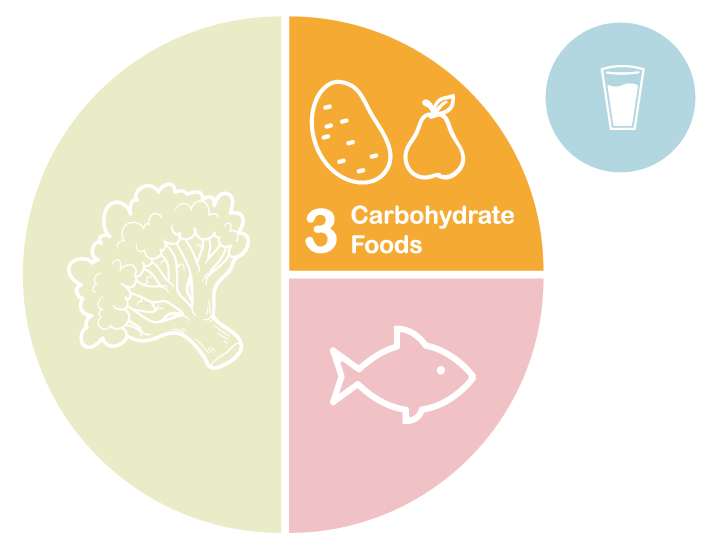Plate Method for Diabetes
If there is a wish, there should be a plan ! Plate method helps you to measure your food & plan your nutrition accordingly.
Use plate method to serve the food. 1/4 of the plate each: raw vegetables. cooked vegetables, proteins and carbohydrates.
To start out, you need a plate that is not too big. The size of our plate usually determines the size of our portions, so you want to start with a reasonably sized plate-we recommend about 9 inches across.
Now that you have the right plate, it's time to fill it! Imagine two lines drawn on your plate breaking it up into three sections:

1. Fill half your plate with nonstarchy vegetables.
Nonstarchy vegetables are lower in carbohydrate, so they do not raise blood sugar very much. They are also high in vitamins, minerals, and fiber, making them an important part of a healthy diet. Filling half your plate with nonstarchy vegetables means you will get plenty of servings of these superfoods.
Examples of nonstarchy vegetables:
- Asparagus
- Broccoli or Cauliflower
- Brussels Sprouts
- Cabbage (green, red, napa, bok choy, chinese)
- Carrots
- Celery
- Cucumber
- Eggplant
- Leafy greens such as kale, collards, mustard greens,
- Mushrooms
- Okra
- Green beans, pea pods, snow peas, and sugar snap peas
- Peppers such as bell peppers and hot peppers
- Salad greens such as lettuce, spinach and other salad mixes
- Tomatoes

2. Fill one quarter of your plate with lean protein foods
Foods high in protein such as fish, chicken, soy products, and cheese are all considered "protein foods."
Proteins foods (especially those from animal sources) usually contain saturated fat, which may increase your risk of heart disease. Lean proteins are lower in fat and saturated fat, making them a healthier choice.
Keep in mind that some plant-based protein foods (like beans and legumes) are also high in carbohydrates.
Examples of lean protein foods include:
- Chicken, and eggs,Fish
- Lean meats
- Cheese and cottage cheese
- Plant-based sources of protein:
- Beans, lentils, hummus, and falafel
- Nuts and nut butters
- Tofu and Plant-based meat substitutes

3. Fill one quarter of your plate with carbohydrate foods
Foods that are higher in carbohydrate include grains, starchy vegetables, beans and legumes, fruit, yogurt, and milk. These foods have the greatest effect on blood sugar.
Limiting your portion of carbohydrate foods to one quarter of your plate can help keep blood sugars from rising too high after meals.
Examples of carbohydrate foods:
- Whole grains such as brown rice, bulgur, oats/oatmeal, popcorn, quinoa, and whole grain products (bread, pasta, tortillas)
- Starchy vegetables such as acorn squash, butternut squash, green peas, parsnips, plantain, potato, pumpkin, and sweet potato/yam
- Beans and legumes such as black, kidney, pinto, and garbanzo beans
- Fruits and dried fruit
- Dairy products like milk, yogurt, and milk substitutes (i.e. soy milk)

4. Choose water or a low-calorie drink
Water is the best choice because it contains no calories or carbohydrates and has no effect on blood sugar. Other zero- or low-calorie drink options include:
- Unsweetened tea (hot or iced)
- Unsweetened coffee (hot or iced)
- Sparkling water/club soda
- Flavored water or sparkling water without added sugar
5. What about combination foods?
Our meals don't always fit neatly into the sections of the plate. Many dishes combine the different food types together, like soups, sandwiches, pizza, pasta, etc.
You can still use the plate method when preparing and portioning combination foods. Just identify the different foods in the dish and think about where they would fit in the plate.
For example, in a slice of pizza, the crust would be the carbohydrate food, the cheese and any meats on top would be the protein foods, and the tomato sauce and any vegetables on top would be the nonstarchy vegetables.
